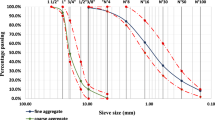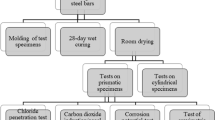Abstract
The use of self-compacting concrete (SCC) facilitates the placing of concrete by eliminating the need for compaction by vibration. Given the highly flowable nature of such concrete, care is required to ensure excellent filling ability and adequate stability. This is especially important in deep structural members and wall clements where concrete can block the flow, segregate and exhibit bleeding and settlement which can result in local defects that can reduce mechanical properties, durability and quality of surface finish.
This paper shows results of an investigation of fresh properties of self-compacting concrete, such as filling ability measured by slump flow and flow time (measured by Orimet) and plastic fresh settlement measured in a columin. The SCC mixes incorporated various combinations of fine inorganic powders and admixtures. The slump flow of all SCCs was greater than 580 mm and the time in which the slumping concrete reached 500 mm was less than 3 s. The flow time was less than 5 s. The results on SCCs were compared to a control mix. The compressive strength and splitting tensile strength of SCCs were also measured.
The effects of water/powder ratio, slump and nature of the sand on the fresh settlement were also evaluated. The volume of coarse aggregate and the dosage of superplasticizer were kept constant. It can be concluded that the settlement of fresh self-compacting concrete increased with the increase in water/powder ratio and slump. The nature of sand influenced the maximum settlement.
Résumé
L'utilisation des bétons autoplaçants (BAP) facilite la mise en place du béton en éliminant la vibration. Étant donné la grande fluidité de tels bétons, des précautions doivent être prises pour assurer une bonne capacité de remplissage et une stabilité adéquate. Ceci est important dans les éléments de structures et de murs, lorsque le béton peut bloquer l'écoulement, entraînant ségrégation et tassement, ce qui peut donc réduire les propriétés mécaniques, la durabilité et la qualité de la surface.
L'article présente les résultats d'une étude des propriétés du béton autoplaçant frais, comme la capacité de remplissage mesurée par l'étalement du cône d'affaissement et le temps d'écoulement (mesuré par Orimet) et le tassement mesuré dans une colonne. Les BAP contiennent différentes combinaisons de matériaux non-organiques et d'adjuvants. L'étalement de tous les BAP était supérieur à 580 mm et le temps d'écoulement où le bétou atteint le diamètre du cône de 500 mm était inférieur à 3 s. Les résultats des BAP ont été comparés au béton de référence. La résistance à la compression et la résistance à la traction des BAP ont aussi été mesurées.
Les effets du rapport eau/liant, de l'affaissement et de la nature du sable sur le tassement ont été aussi évalués. Le volume des gros granulats et le dosage du superplastifiant ont été gardés constants. On peut donc conclure que le tassement du béton autoplaçant frais a augmenté avec la hausse du rapport eau/liant et de l'affaissement. La nature du sable a influencé le tassement maximal.
Similar content being viewed by others
References
Ozawa, K., Maekawa, K. and Okamura, H., ‘Development of high performance concrete’,Journal of the Faculty of Engineering, The University of Tokyo(XLI) 3 (1992) 381–439.
Edamatsu, Y., Nishida, N. and Ouchi, M., ‘A rational mix-design method for self-compacting concrete considering interaction between coarse aggregate and mortar particles’, Proceedings of the First International RILEM Symposium on Self-Compacting Concrete, Stockholm, Sweden (1999) 309–320.
Fujiwara, H., Nagataki, S., Otsuki, N. and Endo, H., ‘Study on reducting unit powder content of high-fluidity concrete by controlling powder particle size distribution’,Concrete Library of JSCE 28 (1996) 117–128.
Khayat, K. H. and Guizani, Z., ‘Use of viscosity-modifying admixture to enhance stability of fluid concrete’,ACI Materials Journal (94)4 (1997) 332–340.
Brettmann, B. B., Darwin, D. and Donahey, R. C., ‘Bond of reinforcement to superplasticized concrete’,ACI Materials Journal (83)1 (1986) 98–107.
Yurugi, M., Sakai, C. and Sakata, N., ‘Viscosity agent and mineral admixtures for highly fluidized concrete’, Proceedings of Concrete Under Severe Conditions: Environment and Loading (volume 2), Edited by K. Sakai, N. Banthia & O. Gjørv, E & FN Spon, Sapporo, Japan, (1995) 995–1004.
Khayat, K. H., ‘Use of viscosity-modifying admixture to reduce top-bar effect of anchored bars cast with fluid concrete’,ACI Materials Journal (95)2 (1998) 158–167.
Sonebi, M. and Bartos, P. J. M., ‘Hardened SCC and its bond with reinforcement’, Proceedings of the First International RILEM Symposium on Self-Compacting Concrete, Stockholm, Sweden (1999) 275–289.
Khayat, K. H., Manai, K. and Trudel, A., ‘In situ mechanical properties of wall elements cast using self-consolidating concrete’,ACI Materials Journal (94)6 (1997) 491–500.
Sedran, T. and de Larrard, F., ‘Optimisation of self compacting concrete, Thanks to packing model’, Proceedings of the First International RILEM Symposium on Self-Compacting Concrete, Stockholm, Sweden (1999) 321–332.
Khayat, K. H., ‘Workability, testing, and performance of self-consolidating concrete’,ACI Materials Journal (96)3 (1999) 346–353.
Manai, K., ‘Evaluation of the effect of chemical and mineral admixtures on the workability, stability and performance of self-compacting concrete’, Master thesis, Université de Sherbrooke, Quebec, Canada, (1995) 182 p.
Trudel, A., ‘Workability, uniformity, and structural behaviour of high-performance self-compacting concrete’, Master thesis, Umversité de Sherbrooke, Quebec, Canada, (1995) 198 p.
Khayat, K. H., Ghezal, A. and Hadriche, M. S., ‘Utility of statistical models in proportioning self-compacting concrete’, Proceedings of the First International RILEM Symposium on Self-Compacting Concrete, Stockholm, (1999) 345–359.
Bartos, P. J. M. ‘An appraisal of the Orimet test as a method for on-site assessment of fresh SCC concrete’, Proceedings, International Workshop on Self-Compacting Concrete, Japan, Kochi University of Technology, (1998), 121–135.
Ozawa, K., Sakata, N. and Okamura, H., ‘Evaluation of self-compactibility of fresh concrete using the funnel test’,Concrete Library of JSCE 25 (June 1995) 59–75.
Author information
Authors and Affiliations
Additional information
Editorial note Prof. Peter J. M. Bartos is a RILEM Senior Member and the Chairman of the RILEM TC NCM ‘Nanotechnology in construction materials’. He paritcipates in the work of RILEM TCs 1620-TDF “Test and design methods for steel fibre reinforced concrete” and 167-COM “Characterisation of old mortars with respect to their repair”. He is a Member of the RILEM Management Advisory Committee. The ACM Centre is a RILEM Titular Member. Dr. M. Sonebi participates in the work of RILEM TC CSC ‘Casting of Self-Compacting Concrete’.
Rights and permissions
About this article
Cite this article
Sonebi, M., Bartos, P.J.M. Filling ability and plastic settlement of self-compacting concrete. Mat. Struct. 35, 462–469 (2002). https://doi.org/10.1007/BF02483133
Received:
Accepted:
Issue Date:
DOI: https://doi.org/10.1007/BF02483133




